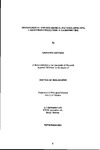PHYSIOLOGICAL AND BIOCHEMICAL FACTORS AFFECTING CAROTENOID UTILIZATION IN SALMONID FISH
| dc.contributor.author | PAGE, GREGORY IAN | |
| dc.contributor.other | School of Biological and Marine Sciences | en_US |
| dc.date.accessioned | 2013-10-25T11:55:29Z | |
| dc.date.available | 2013-10-25T11:55:29Z | |
| dc.date.issued | 2001 | |
| dc.identifier | NOT AVAILABLE | en_US |
| dc.identifier.uri | http://hdl.handle.net/10026.1/2383 | |
| dc.description.abstract |
Carotenoid utilization in rainbow trout (Oncorhynchus mykiss Walbaum) and Atlantic salmon (Salmo salar L.) has been investigated with respect to tissue distribution of carotenoids and the role of the liver on the bioavailability of the lipid soluble carotenoids, astaxanthin and canthaxanthin. Species-specific and tissue-specific accumulations were noted for astaxanthin and canthaxanthin in the rainbow trout and Atlantic salmon, possibly indicating fundamental differences in their utilization in these species. The liver and the kidney were revealed to be the major tissues involved in carotenoid metabolism in both rainbow trout and Atlantic salmon. Apparent digestibilities (-96% and -30% for rainbow trout and Atlantic salmon, respectively) and flesh carotenoid retentions (-12% and -5.4% for rainbow trout and Atlantic salmon, respectively) differed significantly between species, suggesting that rainbow trout are more efficient depositors of carotenoids within the flesh. Isolated rainbow trout liver perfusion experiments revealed small differences in the uptake of astaxanthin and canthaxanthin. Uptake of astaxanthin in both synthetically-derived and serum-derived models showed saturable uptake mechanism that occurred earlier than for canthaxanthin. These results can potentially offer an explanation for the better utilization of astaxanthin in rainbow trout, where the liver reduces the bioavailability of canthaxanthin through continued uptake. Results show a low hepatic extraction ratio (0.03-0.07), in line with published post-prandial elimination rates. Neither astaxanthin nor canthaxanthin significantly induced hepatic or renal xenobiotic-metabolizing enzymes in the rainbow trout, contrary to published reports in rats and mice. This may imply fundamental species-specific differences in the metabolic pathways for these carotenoids. Histochemical investigations revealed that both carotenoids significantly impacted liver structure, resulting in higher levels of total lipids and mucopolysaccharides. This is thought to be due to their antioxidant functions and their provitamin A activity. Carotenoid-treated fish also had higher levels of glycogen phosphorylase in liver sections, providing the first evidence in fish for the possibility of glucuronidation of their metabolites. The present investigations demonstrate the liver to be a major organ in carotenoid metabolism, and consequently affects carotenoid distribution and availability. In addition, carotenoid supplementation significantly affects liver structure and may potentially enhance its function. Furthermore, these investigations have provided new avenues of investigation into the use of isolated organ perfusions for biochemical nutrition research, and expanded the knowledge of liver physiology and biochemistry. | en_US |
| dc.description.sponsorship | EWOS Innovation AS, Dirdal, Norway | en_US |
| dc.language.iso | en | en_US |
| dc.publisher | University of Plymouth | en_US |
| dc.title | PHYSIOLOGICAL AND BIOCHEMICAL FACTORS AFFECTING CAROTENOID UTILIZATION IN SALMONID FISH | en_US |
| dc.type | Thesis | |
| dc.identifier.doi | http://dx.doi.org/10.24382/4604 | |
| dc.identifier.doi | http://dx.doi.org/10.24382/4604 |
Files in this item
This item appears in the following Collection(s)
-
01 Research Theses Main Collection
Research Theses Main


